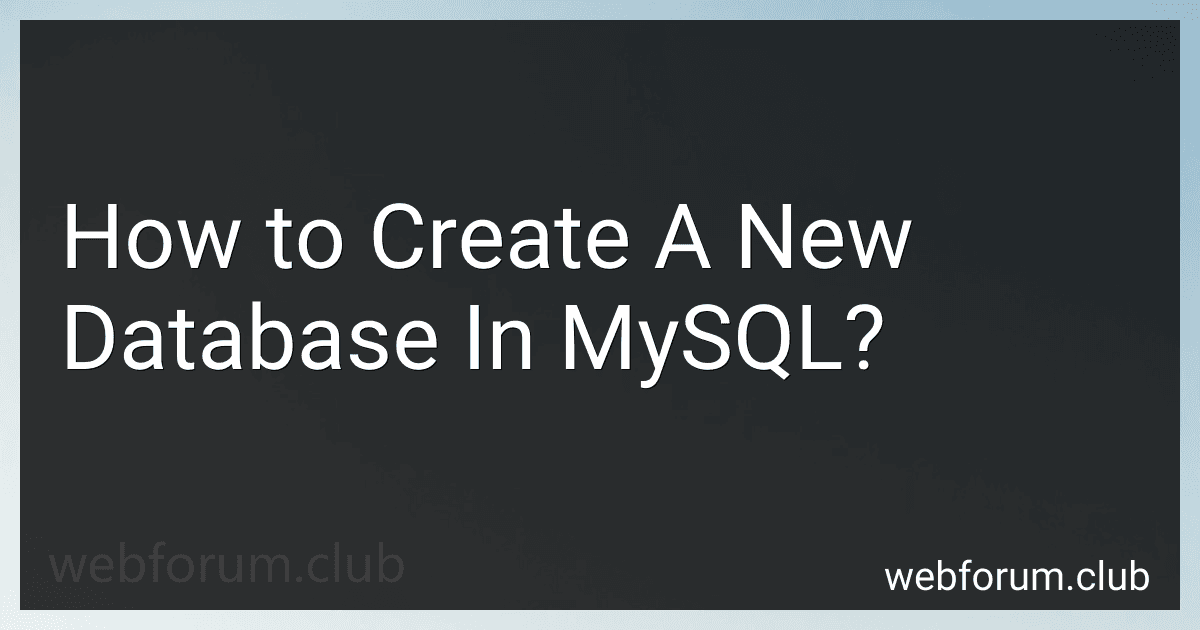To create a new database in MySQL, you can follow these steps:
- Launch the MySQL command-line client by opening a terminal or command prompt window.
- Enter your MySQL username and password to connect to the MySQL server. The command usually looks like this: mysql -u your_username -p
- Once you are connected to the MySQL server, you can create a new database by executing the following SQL statement: CREATE DATABASE database_name; Here, database_name is the name you want to give to your new database. Make sure to choose a meaningful name.
- To verify that the database has been created, you can use the following command: SHOW DATABASES; This will display a list of all the databases on the MySQL server, including the one you just created.
That's it! You have successfully created a new database in MySQL. You can now start using it to store and manage your data.
What is the syntax for creating a backup of a MySQL database?
The syntax for creating a backup of a MySQL database using the command-line is as follows:
mysqldump -u [username] -p [password] [database_name] > [backup_file.sql]
Here, replace [[username](https://ubuntuask.com/blog/how-to-change-committed-user-name-in-bitbucket)] with the username of your MySQL user, [password] with the password for the user, [database_name] with the name of the database you want to backup, and [backup_file.sql] with the filename you want to give to the backup file.
How to specify a collation for a new database in MySQL?
To specify a collation for a new database in MySQL, you can use the CREATE DATABASE statement with the COLLATE clause. Here's the syntax:
CREATE DATABASE database_name [COLLATE collation_name]
Replace database_name with the name you want to give to the new database, and collation_name with the specific collation you want to use.
For example, if you want to create a database called "my_database" with a collation of "utf8_general_ci", you would use the following query:
CREATE DATABASE my_database COLLATE utf8_general_ci;
Make sure to choose an appropriate collation based on the character set and language requirements of your database.
What is the difference between a database and a table in MySQL?
In MySQL, a database is a collection of related data that is organized and structured. It serves as a container for tables, views, procedures, and other database objects. It typically has its own set of credentials for accessing and managing the data within it.
On the other hand, a table is a basic unit of storage in a database. It is a structured collection of data organized in rows and columns. Tables hold the actual data that is being stored, and they define the structure and format of the data using columns with specific data types.
In summary, a database is a logical container that holds multiple tables and other objects, while a table is a physical object within a database that stores the actual data in a structured manner.
How to change the default storage engine for a new database in MySQL?
To change the default storage engine for a new database in MySQL, you can follow these steps:
- Open your MySQL configuration file (my.cnf or my.ini) in a text editor. The location of the file depends on your operating system and MySQL installation.
- Look for the [mysqld] section in the configuration file and add or modify the following line to set the default storage engine: default-storage-engine=engine_name Replace "engine_name" with the name of the storage engine you want to set as the default. For example, if you want to set InnoDB as the default storage engine, you can use: default-storage-engine=InnoDB
- Save the configuration file and exit the text editor.
- Restart the MySQL service to apply the changes. The exact method for restarting the service depends on your operating system. For example, on a Linux system, you can use the following command: sudo service mysql restart
- After the MySQL service restarts, any new databases created will use the specified default storage engine.
Note: Changing the default storage engine does not affect existing databases. To change the storage engine for an existing database, you need to alter the individual tables within the database.
